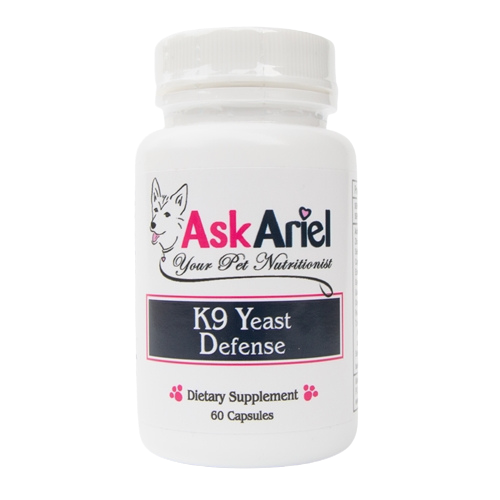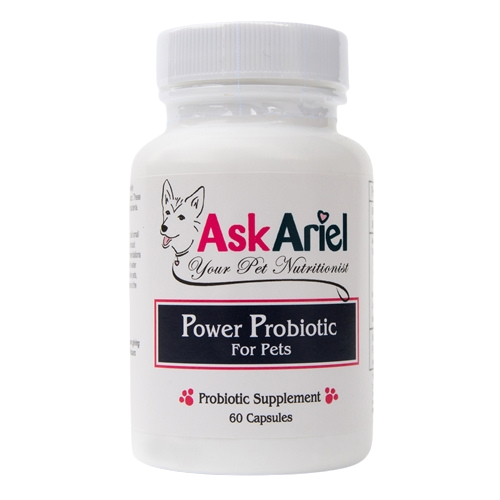Yeast Infection in Dogs: Symptoms, Causes & TreatmentYeast Infection in Dogs: Probiotics and Natural RemediesIs your dog licking and chewing on his paws? Does he have skin redness or a smelly odor? These uncomfortable symptoms can be a sign of a yeast infection in dogs. When a dog's natural balance of yeast, bacteria, and fungi is disrupted, it can lead to overgrowth and various symptoms like skin and ear infections. With a diet change and the proper supplements, you can give your dog needed relief from the itching and irritation of chronic yeast. Symptoms of Dog Yeast InfectionsDogs with yeast infections have symptoms that are similar to those caused by allergies and bacterial infections. Dogs will itch, lick, chew, scoot and scratch to relieve their discomfort. Common signs of yeast dermatitis may include:
Dogs will lick until the skin is raw and inflamed. This can cause hot spots and lead to infection. Butt scooting is another attempt to calm the itchiness. Long-term dog yeast infections may result in blackened skin, also called “elephant skin.” Brown ear discharge that resembles coffee grounds is usually a symptom of ear mites, not a yeast infection. Ear mites are contagious from one dog to another. Since yeast infections come from the inside, the good news is that they are not contagious to other pets. Diagnosing Yeast Dermatitis in DogsThe clinical signs of yeast dermatitis are quite evident. Candida species (i.e., Candida albicans) are the most common cause of yeast infections in dogs. Malassezia pachydermatitis is another common fungus responsible for yeast dermatitis in dogs. To confirm a diagnosis, most vets will perform a cytology or culture. A cytology includes looking at skin cells under a microscope. A culture is performed by rubbing a swab across the skin and sending it to the lab for analysis. A culture test can also determine which medications will be effective in treating the specific fungus. Yeast and fungal growth from a culture can take time, so most vets prefer cytology for faster results. Common Causes of Yeast Infections in DogsYeast, bacteria and fungi are naturally found on the skin and in the gut of your dog. These organisms are often referred to as the “microbiome.” When present in a healthy amount, they play an important role in your dog’s overall health. If the immune system becomes weak or compromised, the yeast will overpopulate in the gut and the effects start to spread to the skin. The skin is your dog’s largest elimination organ. As the body is trying to push out the yeast, the result is stinky, itchy skin. Yeast infections are not contagious; your dog did not get this infection from another dog. Yeast infections in dogs often recur unless the underlying allergy or skin condition is controlled. Here are some of the most common causes of dog yeast infections: Antibiotic and Steroid UseYeast symptoms commonly occur along with a bacterial infection, so antibiotics and steroids are often prescribed. Antibiotics kill off the bad bacteria as well as the good bacteria needed for a healthy immune system. Prescription antifungal medications can also create an imbalance. Steroids (i.e. prednisone) calm yeast infection symptoms by reducing inflammation and suppressing the immune response. These medications can upset the microbiome and create a vicious cycle of dog yeast infection symptoms. Once antibiotics and/or steroids are stopped, the symptoms will usually return. Food and Environmental AllergiesAllergies in dogs can be caused by environmental allergens such as grass, pollen or dust mites. Dogs will have a similar type of allergic response to food allergens. Common food allergens can include things such as poultry, dairy or peanut butter. Allergies create inflammation and red, itchy skin. When dogs scratch themselves, they open the protective skin barrier. Tiny scratches or lesions become the perfect breeding ground for bacteria, fungi or yeast to cause infection. High-Carbohydrate DietDog foods and treats that are high in starchy carbohydrates, sugars and grains can help yeast to grow. All carbohydrates, including soy, corn, potatoes, wheat, peas and rice, are some form of sugar. When there is too much sugar in your dog’s body, it provides food for bad bacteria and yeast to grow. Sugar is the ultimate fuel for candida yeast. Dry kibble, even a high-quality grain-free brand, is extremely high in carbohydrates and fillers. Carbohydrates convert to sugars during digestion. Vegetables such as sweet potatoes and potatoes are used in most grain-free dog foods. These should be avoided by dogs with yeast infections. Sweets (honey, molasses, corn syrup) and breads should also be avoided. Heat and HumidityYeast thrives in warm, moist environments. Dog yeast infections occur most often in the warm summer months due to higher humidity levels. Try to keep your dog indoors when the humidity is high. Many dogs love to swim in the summer. Wet skin and ears can create an ideal environment for yeast growth. Make sure to dry your pups, especially in the groin and ears, after they swim. Genetic PredispositionCertain breeds seem to be genetically more likely to suffer from yeast infections. These breeds include cocker spaniels, basset hounds, West Highland white terriers, Malteses, shih-tzus, Lhasa apsos, Chihuahuas, dachshunds, German shepherds, boxers and poodles. Your dog’s skin contains a wide variety of bacteria and fungi. It sounds gross, but your dog has Candida albicans, staphylococcus, Malassezia pachydermatis and streptococcus canis on its skin. These organisms coexist and do not normally cause a problem until something creates an imbalance. Once there is an imbalance, pathogens will take advantage of the opportunity to proliferate. Yeast infections are one of many possible opportunistic infections. How Do Veterinarians Treat Dog Yeast InfectionsTraditional veterinary treatments for yeast infections can be topical or oral. For chronic yeast infections, which often include concurrent bacterial overgrowth, a combination of both is used. Topical treatment includes the use of medicated antifungal shampoos. For ear yeast infections or skin hot spots, topical ointments may be prescribed. Oral antifungal medications are often effective in treating yeast infections and Malassezia dermatitis, but they must be given for months at a time. Corticosteroid medications and plant sterol supplements can be used to reduce inflammation. Dogs are treated with antibiotics if they have developed a secondary skin infection. The use of antibiotics and antifungal medications carry the risk of potential side effects. Antifungals can have adverse effects on the liver, especially if used long term. The FDA has issued several warnings regarding the safety of certain antifungal medications in humans, as it carries the risk of severe liver injury and adrenal gland problems. The FDA does not mention whether the same effects on the liver and drug interactions would occur with dogs, but if your dog is using this medication, please contact your veterinarian. Tips to Prevent Dog Yeast Infections
Recommended Diet for Dogs Prone to Yeast InfectionsDog licking is due to itchiness and irritation from the INSIDE. While topical lotions and shampoos will help to treat sores and skin infections, in order to stop the urge to lick and chew, you must control the itching and discomfort that is causing it in the first place. By changing your dog's diet and adding natural, veterinarian-approved supplements, you can give your dog fast relief from the itching and irritation of chronic yeast and ear infections by balancing your dog’s microbiome. The best food for dogs with yeast infections is a frozen low-carbohydrate raw novel-protein diet. Some meat proteins, like chicken, turkey, duck and beef, are potential allergens for dogs. Diets high in grains (corn, wheat, rice) can cause inflammation and skin problems in dogs. Dry food, for example, is made with starchy carbohydrates that convert to sugar, which can fuel yeast growth. Dairy products, like milks or yogurts, are very high in sugars and should be avoided. Potatoes and sweet potatoes are starchy vegetables and are not recommended for dogs with yeast. Green vegetables such as zucchini or green beans are excellent additions to your dog’s meals. They also make great treats. Treating Dog Yeast Infections Naturally with ProbioticsTreating yeast in dogs with natural supplements can help reduce symptoms and prevent chronic infections. Over the counter probiotics pet supplements are essential in helping to maintain balance in the microbiome. Probiotics replenish good bacteria and support digestive and immune health. Studies have shown that caprylic acid can help to break down the membranes of candida cells. Herbs such as pau d’arco, oregano, grapefruit seed extract and olive leaf extract all contain natural antifungal properties that can help kill yeast and fungal pathogens.  K9 Yeast Defense - K9 Yeast Defense is an all-natural yeast remedy for chronic ear infections, licking at genitals, chewing on paws, facial rubbing and other yeast infection symptoms. It contains time-tested natural antifungal ingredients like pau d’arco, grapefruit seed extract, caprylic acid and oregano, that are scientifically proven to control fungal dermatitis in dogs. Helps to relieve yeast infection symptoms and restore proper balance to your dog's microbiome. K9 Yeast Defense - K9 Yeast Defense is an all-natural yeast remedy for chronic ear infections, licking at genitals, chewing on paws, facial rubbing and other yeast infection symptoms. It contains time-tested natural antifungal ingredients like pau d’arco, grapefruit seed extract, caprylic acid and oregano, that are scientifically proven to control fungal dermatitis in dogs. Helps to relieve yeast infection symptoms and restore proper balance to your dog's microbiome. Power Probiotic - K9 Yeast Defense works best when combined with Power Probiotic to properly balance intestinal flora. When dogs take antibiotics or steroid medications, this depletes the friendly bacteria needed to control yeast overgrowth. Power Probiotic is the best probiotic for yeast infections in dogs! Backed by scientific research, this powerful, multi-strain formula repopulates the good, friendly bacteria your dog's digestive system needs. It’s pure, safe and natural. Many dogs love the taste of Power Probiotic! Power Probiotic - K9 Yeast Defense works best when combined with Power Probiotic to properly balance intestinal flora. When dogs take antibiotics or steroid medications, this depletes the friendly bacteria needed to control yeast overgrowth. Power Probiotic is the best probiotic for yeast infections in dogs! Backed by scientific research, this powerful, multi-strain formula repopulates the good, friendly bacteria your dog's digestive system needs. It’s pure, safe and natural. Many dogs love the taste of Power Probiotic!Need Help?Yeast infections are a common cause of itching and irritation in dogs. We always recommend consulting with your veterinarian to obtain a proper diagnosis before using natural treatments at home. We understand how hard it is when your pet is suffering from yeast infections, and we will do all we can to help. It can be confusing to know which dog supplements would be appropriate for your pet. Please email us at [email protected]. Please note that we cannot provide consultative advice due to veterinary regulations, but we will be happy to provide articles and information so that you can make an informed decision about what's best for your pet. |